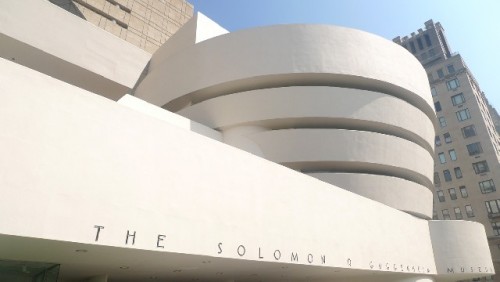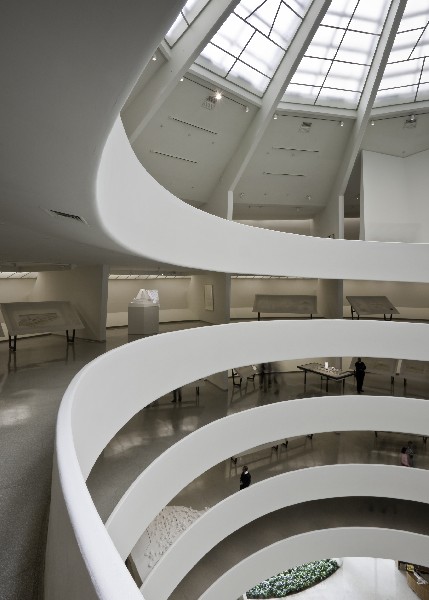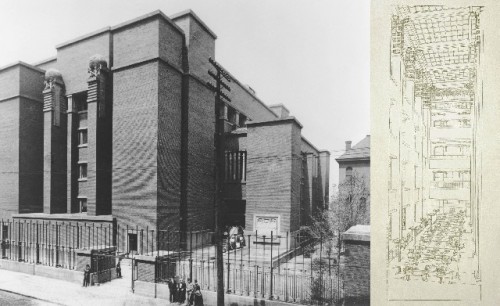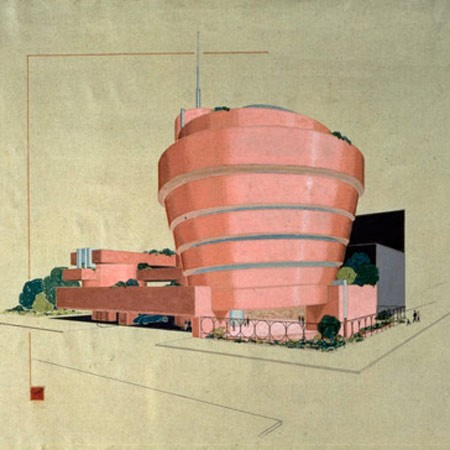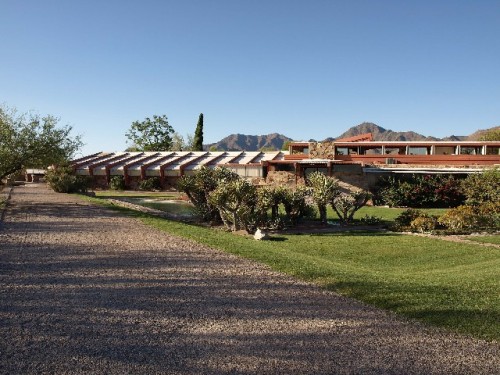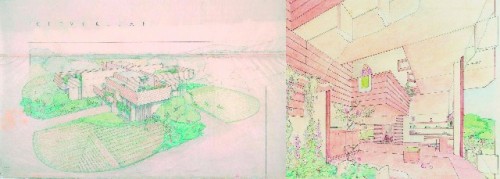Guggenheim Museum Marks 50th Anniversary
Frank Lloyd Wright: From Within Outward Exhibition
By: Mark Favermann - Jul 04, 2009
Just the name Guggenheim Museum evokes the image of the spiraling sculptural white form that houses the renown museum that is the only major structure created by Frank Lloyd Wright in New York City. It is a cultural and architectural landmark. Though now quite common, it was the first art museum to be designed as an art object itself. It is a symbolic and literal capstone to Wright's long roller coaster career. This year the Solomon R. Guggenheim Museum is celebrating the 50th Anniversary of this iconic structure.In 1960 a few months after it opened on October 21, 1959, I first saw the sleek, streamlined cylindrical white building when I was 12 and visiting NYC with my feisty grandmother. Though not knowledgeable about art and probably reactionary toward contemporary art, nevertheless she wanted to see what all the fuss was about. She seemed quite old at the time to me, but since she was born in 1897, she was roughly my current age. And certainly, I am not old. Anyway, at the time, as a kid who loved to draw and paint from a much less sophisticated Virginia, I was excited to see this new museum in New York. Newspapers, magazines and television were full of pictures, articles and stories about the new rather strange and unique looking museum by the famous old architect.
We arrived by taxi, entered the building, bought tickets and were directed to the elevators. Stepping off at the top floor, we began to wind our way down the ramped floor. Later, even as a pre-adolescent, I marveled at how effortlessly my grandmother walked down the whole structure. Remembering Wright was a very old man when he designed it (in his late 80's and 90's), it was perfectly logical to me that he had created the structure to ease the museum experience for older people like my grandmother. This was my assessment at the time anyway. No one seemed to argue with me, so I thought that I was correct. I easily walked down the ramp when I recently visited as well. Perhaps this experience led to my unbounded interest in architecture, design and form and function?
Starting last May 15 through August 23, 2009 to celebrate the golden anniversary of the museum, the Guggenheim brought together 64 projects, many of which have never before been seen by the public. This exhibition, Frank Lloyd Wright: From Within Outward, which fills the museum, broadly demonstrates the resonance and continued influence of Wright. Many of the works displayed were never built. There structure was realized only on paper and in model form. Though often compelling and brilliantly rendered, all of these projects are not necessarily at the top of Frank Lloyd Wright's professional prowess. Displayed here are an inventory of projects, sometimes warts and all, that humanistically demonstrate not just the best but some of the weakest of his concepts. In a way, these flawed sometimes mediocre ideas add even greater luster to this generally golden display underscoring his best work.
The range of the 64 projects illustrates the scope and depth of Wright's long architectural practice. There are churches, synagogues, office buildings, performance spaces, public and civic structures, private residences and urban megastructures. The exhibition is presented with dynamic videos and digital animations, period photographs, archival original hand drawn renderings and sketches and elegant three dimensional scale models. From Within Outward illuminates this iconic architect's concepts of space and form while revealing a contemporary relevance to 21st Century design.
The exhibition took its title from Wright's musings on the importance
of interior space in shaping a structure's exterior. Wright felt that the interior room was the great fact of a building that needed to be expressed in the exterior as space enclosed. The Guggenheim Museum is perhaps the greatest example of Wright's intentions in which the interior form shapes the exterior shell of a structure.
When the Solomon R. Guggenheim opened 50 years ago, the museum building like much of Wright's work drew both lavish praise and great criticism. Wright had reinvented the concept of the museum building and how the viewer experiences art. His career and the Guggenheim Museum's identity were forever intertwined.
This exhibit focuses on the diversity of Frank Lloyd Wright's architectural vision and the ways in which he sought to realize it often conveying fresh perspectives on how buildings are formed by space, form and materials. The major concept of the exhibition was to reflect the recognition of the great contemporary relevance to today's architecture and design of Wright's design philosophies that embraced culture, technology and environmental concerns. Many of the drawings and images came from The Frank Lloyd Wright Archives which is owned by the Frank Lloyd Wright Foundation in Scottsdale, Arizona at Wright's studio/house Taliesin West.
Over the course of his 72 year career, Wright (1897-1959) developed a new sense of architecture in which form and function were inseparable. He died six months before the opening of The Solomon R. Guggenheim Museum. Frank Lloyd Wright is celebrated for the awe-inspiring beauty and tranquility of his designs often using nature and human structure to develop a physical and aesthetic harmony. He used geometric simplicity as a consistent visual grammar that was punctuated by material form and natural environmental integration.
From Within Outward was organized in a loosely chronological way. The installation began with earlier designs on the lower level and progressed through the upper floors to later designs. Included throughout the exhibition were oral histories from clients, friends, architects and apprentices reflecting experiences of living and working in Wright-designed spaces. These were well-illustrated by period photographs, animations and videos that enlivened the archival drawings, sketches and newly crafted models.
Interestingly, the original color that Wright wanted to use for the Guggenheim Museum exterior was to be a pink tone or a very soft red. This was eventually overruled by the Guggenheim family, but original drawings are included in the display. The much lamented Larkin Company Administration Building (1902-06) in Buffalo was wonderfully exhibited to demonstrate the quality of this now long ago torn down structure. The Oak Park, IL Unity Temple (1905-08) still resonates as a beautifully spatial house of worship. Strangely, the elegant but rather weird renderings for the never built Gordon Strong Automobile Objective and Planetarium for Sugarloaf Mountain, MD (1924-25) previews the structural thinking for the Guggenheim nearly a half century later.
Of course, other famous Wright's structures were also included. Among these were the great but now demolished Imperial Hotel in Tokyo (1913-22), Taliesin West (1932-59), the unbuilt Mile High Office Tower for Chicago (1956) and the hexagonal Beth Sholom Synagogue in Elkins Park, PA (1956). Yet, what was most startling were s few of the literal clunkers in the show, specifically the monstrosity that was designed for Huntington Hartford in Los Angeles and the kitsch project for the Shah of Iran in Tehran. Both projects were thankfully unbuilt.
The Huntington Hartford Sports Club/Play Resort (1947) was a futuristic series of terraced bowl-like shapes set on a hill. This was more flying saucer than utopian design.The project for Tehran included several monumental structures and civic buildings along with mega-scaled statues that seemed to be influenced by Disneyland and movie sets from Biblical sagas. Over the top would not be enough of a description for both of these projects. Awkward and strained would be kind references. However, the bad made the very good and great projects appear even better in this exhibition context.
From Within Outward is an exhibit that speaks to us visually, culturally and environmentally. It strongly and at times eloquently communicates about the architecture and design visions of Frank Lloyd Wright. This was a wonderful way to celebrate the genius of this unique man by both his built and unbuilt work as well as one of his great masterworks.

